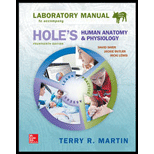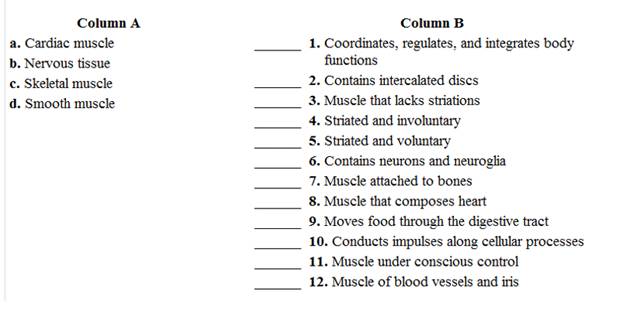
Concept explainers
Match the tissues in column A with the characteristics in column B. Place the letter of your choice in the space provided. (Some answers may be used more than once.) 
To match:
The term from column A to the correct description in column B.
Introduction:
Nervous and muscular tissue has the highest degree of excitability, which are therefore described as excitable tissues. Nervous tissue consists of neurons, or nerve cells, and a much greater number of supportive neuroglia cells, which protect and assist the neurons. There are three types of muscle tissues namely; skeletal, smooth and cardiac muscles. Muscle tissues are characterized by the presence of elongated cells called muscle fibers, which can contract to create bodily movements.
Answer to Problem 2.1A
The table below represents the correct match from the Column A to Column B.
| Column A | Column B |
| b. Nervous tissue | 1. Coordinates regulate and integrate body function. |
| a. Cardiac muscle | 2. Contain intercalated discs |
| b. Smooth muscle | 3. The muscle that lacks striations |
| a. Cardiac muscle | 4. Striated and involuntary |
| b. Skeletal muscle | 5. Striated and voluntary |
| c. Nervous tissue | 6. Contains neurons and neuroglia |
| d. Skeletal muscle | 7. Muscle attached to bones |
| a. Cardiac muscle | 8. The muscle that composes the heart |
| e. Smooth muscle | 9. Moves food through the digestive tract |
| b. Nervous tissue | 10. Conducts impulses along cellular processes |
| c. Skeletal muscle | 11. Muscle under conscious control |
| d. Smooth muscle | 12. Muscle of blood vessels and iris |
Explanation of Solution
- The brain of the central nervous system is responsible for the coordination of body function and integration of most sensory information both consciously and unconsciously. Different parts of the brain are responsible for the regulation of homeostasis.
- Cardiac muscle cells are joined end to end by junctions called intercalated discs. They appear as dark transverse lines separating each cardiocyte from the next.
- Smooth muscle cells are not striated and are fusiform in shape with nucleus located to its center and functions under involuntary control. Smooth muscle lacks striations because the contractile proteins of smooth muscle are not arranged in a regularly overlapping way.
- Cardiac muscle is located only in the heart wall. Cardiac muscle is under the control of the autonomic nervous system. It is involuntary and functions to pump blood. Cardiac muscle cells are have striated appearance due to the presence of intercalated discs.
- Skeletal muscle consists of long, cylindrical cells called muscle fibers. Skeletal muscle is described as striated and voluntary. They appear striated due to alternating light and dark bands, created by the overlapping pattern of cytoplasmic protein filaments that cause muscle contraction. Skeletal muscle is innervated by motor neurons and we usually have conscious and involuntary control over skeletal muscles.
- The nervous tissue that occurs in the brain, spinal cord and peripheral nerves contain neurons (nerve cells) and neuroglia (glial cells), which are supportive cells located in close association with neurons.
- Skeletal muscles are usually attached to bones and have functions such as; body movements, maintaining posture, heat production and providing protection. Skeletal muscles are under conscious control and are considered voluntary.
- Cardiac muscle is located only in the heart wall and the cells are branched, striated and have a single nucleus. It is under involuntary control.
- Smooth muscle forms layers in the walls of the digestive, respiratory, and urinary tracts, uterus, blood vessels, and other organs. In parts of the digestive tract, esophagus and small intestine, adjacent layers of smooth muscle are present with one layer encircling the organ and the other layer running longitudinally. During the contraction of the circular layer, contents such as food propel through the organ.
- Neurons, also called nerve cells are considered excitable cells because they can generate signals called action potentials along the neuron to pass a message to another neuron or a muscle or a gland.
- Skeletal muscle consists of long, cylindrical cells called muscle fibers. Skeletal muscle is described as voluntary. The term, voluntary, refers to the fact that we usually have conscious control over skeletal muscles.
- Small amounts of smooth muscle are found in the iris of the eye, but most of it forms layers in blood vessels and other organs. Smooth muscle forms adjacent layers with one layer encircling the organ and the other layer running longitudinally. The contraction of the longitudinal layer makes the organ shorter and thicker. Smooth muscle is very important in controlling the blood pressure and flow by regulating the diameter of blood vessels.
Want to see more full solutions like this?
Chapter 10 Solutions
Laboratory Manual for Holes Human Anatomy & Physiology Fetal Pig Version
Additional Science Textbook Solutions
Campbell Essential Biology with Physiology (5th Edition)
MARINE BIOLOGY
Campbell Biology in Focus (2nd Edition)
Essentials of Human Anatomy & Physiology (11th Edition)
Microbiology with Diseases by Body System (5th Edition)
Genetics: Analysis and Principles
- What happens to the tissue if it is not immediately fixed?arrow_forwardwhat is the name of the TISSUE TYPE (entire bracketed area) at the end of the arrow for letter D? D1) What is the FUNCTION of the TISSUE TYPE?arrow_forwardPeter suffers from a knee injury involving damage to bone, cartilage and ligaments because of an accident during basketball practice. What can you tell him about the healing of these tissues? Explain your answer in 4 to 5 sentences. Indicate the reference/s of your answer.arrow_forward
- what is the full name of the layer at the end of the arrow for letter G? What is the name of this tissue type and what is its function?arrow_forwardWhat are the two types of tissue in this picture !?arrow_forwardMrs. Thompson was smoking a cigarette while using oxygen. The oxygen ignited causing 5th degree burns on Mrs. Thompson's forehead. To treat this area a. excising the tissue b. waxing c. excising the tissue, wax reconstruction, and cosmetics d. corrective cosmetic treatmentarrow_forward
- Surgical Tech For Surgical Tech Pos CareHealth & NutritionISBN:9781337648868Author:AssociationPublisher:Cengage
 Human Biology (MindTap Course List)BiologyISBN:9781305112100Author:Cecie Starr, Beverly McMillanPublisher:Cengage Learning
Human Biology (MindTap Course List)BiologyISBN:9781305112100Author:Cecie Starr, Beverly McMillanPublisher:Cengage Learning


